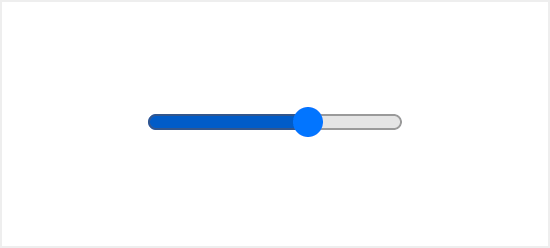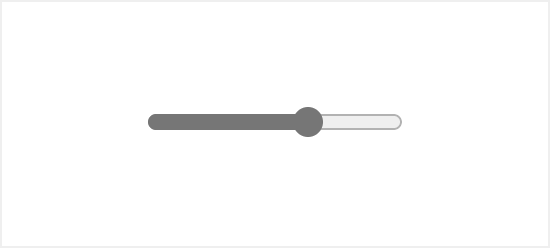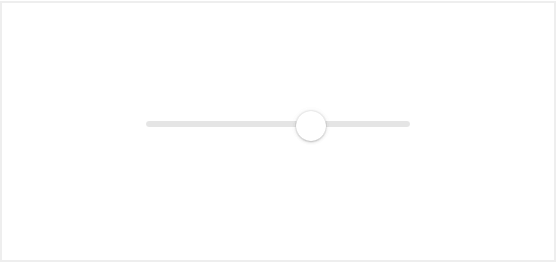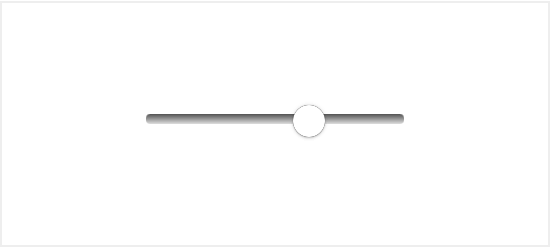- Работа с ползунком range в JS
- Как работать с ползунком в JS
- Практическое задание
- Продолжаем работать с ползунком range
- Styling range input with CSS and JavaScript for better UX
- Accent color
- CSS selectors for the range input
- Improving usability
- Specify the output element to display the selected value
- Specify the number input that is synced to the range input
- A sprinkle of JavaScript
- Range input for RTL direction
- Custom range input Demo
Работа с ползунком range в JS
В HTML5 вводится новые значения атрибута type, в частности — type=»range», который представляет из себя ползунок. Давайте разберем как работать с таким элементом.
Пример использования в коде html:
И результат применения ползунка в коде:
Для работы с ползунком введены следующие атрибуты:
- max — максимальное значение элемента (соответствует крайнее правое положение ползунка). Число.
- min — минимальное значение элемента (соответствует крайнее левое положение ползунка). Число.
- step — шаг ползунка. Число.
Пример применения атрибутов, представлен ниже.
Кроме того, как и с любым элементов HTML к input type=»range» можно применить оформление CSS.
Как работать с ползунком в JS
Поскольку ползунок — это элемент Input, то для считывания его значения можно применять свойство value. В следующем примере мы будем считывать значение ползунка и выводить его в абзац.
Обратите внимание на новое событие oninput. Событие OnInput — срабатываем при любом изменении в элементе формы, например при вводе нового символа, или при перемещении ползунка на 1px. В отличие от события OnChange — которое срабатываем только при потере фокуса элементом, oninput срабатываем при любом изменении в элементе. Данное событие добавляет ползунку интерактивности.
Событие onchange также удобно использовать вместе с элементом select.
Практическое задание
Задание 1. Замените событие OnInput в представленном примере на событие onchange. Изучите как изменилось поведение элементов. Когда происходит обновление значения в абзаце?
Задание 2. Задайте ползунку минимальное значение 50, а максимальное 150. Изучите какое минимальное и максимальное значение выводиться в абзаце?
Задание 3. Задайте шаг ползунка равным 10. Как происходит изменение значений в абзаце?
Задание 4. Задайте шаг изменения значений равным 7. Как измениться максимальное и минимальное значение?
Продолжаем работать с ползунком range
Внимание! Значения считанные из свойства value являются строкой. Не забывайте их переводить в число с помощью функции parseInt(ваша строка).
Давайте решим простую задачу: выведем значение ползунка в input. Для этого необходимо значение свойства ползунок.value передать в свойство input.value. Пример представлен ниже:
Styling range input with CSS and JavaScript for better UX
To style the range input with CSS you’ll need to apply styles to two pseudo-elements: ::-webkit-slider-thumb and ::-webkit-slider-runnable-track . Find out how you can apply custom styling and make the range input more functional and appealing.
The input element with a type of range is a native HTML form UI element that allows users to select a value by dragging a slider over a range field.
The default browser styling for this element is very basic and doesn’t provide enough information to the user which might confuse one. Also, the appearance of the range input element is different across browsers.
Range input HTML:
Range input appearance on different browsers:



Luckily there are ways you can improve that using nothing but native CSS and JavaScript.
Accent color
One simple way to customize the appearance of the range input without any specific selectors or additional HTML is to change the color of the range.
To do so you can define the accent-color property for the input[type=»range»] selector which will update the color of the track and thumb.
input[type="range"] accent-color: coral; > CSS selectors for the range input
The range input widget consists of two parts the thumb and the track. Each one of these parts has its own pseudo-class selector for styling with a vendor suffix for cross-browser support.
input[type="range"] -webkit-appearance: none; margin-right: 15px; width: 200px; height: 7px; background: rgba(255, 255, 255, 0.6); border-radius: 5px; background-image: linear-gradient(#ff4500, #ff4500); background-size: 70% 100%; background-repeat: no-repeat; > input[type="range"]::-webkit-slider-thumb -webkit-appearance: none; height: 20px; width: 20px; border-radius: 50%; background: #ff4500; cursor: ew-resize; box-shadow: 0 0 2px 0 #555; transition: background .3s ease-in-out; > input[type=range]::-webkit-slider-runnable-track -webkit-appearance: none; box-shadow: none; border: none; background: transparent; > To indicate the selected value, we can add a color from the start of the track up until the thumb. To do that we can use the background-image property with the linear-gradient() value. The background-size property will be used to set the size, which can later be updated with JavaScript.
Improving usability
The default range input doesn’t specify any values selected. Which makes it hard for users to understand what value is currently selected.
While the hash marks and labels on the range input are a great way to aid users visually, this feature is yet to become available.
However, there are a few ways you can improve that with some additional HTML and JavaScript:
- Specify the output element to display the selected value
- Specify the number input that is synced to the range input
Specify the output element to display the selected value
The output element on the side of the range input will display the selected value. You’ll have to add an id attribute for the output element, and an oninput attribute for the range input with a short function as a value, that will update the output element contents.
type="range" min="0" max="100" oninput="rangevalue.value=value"/> id="rangevalue">50 Specify the number input that is synced to the range input
To take it a step further you can add a number input next to the range element.
That way the user will see the selected value and will have an option to modify it via the number input, which can be a better experience especially for mobile users.
type="range" value="50" min="0" max="100" id="range" oninput="rangevalue.value=value"/> type="number" id="rangevalue" value="50" oninput="range.value=value"> A sprinkle of JavaScript
To finalize we’ll need some JavaScript code to make it all work. The oninput attribute is already updating value based on a target element.
But to update the selected area of the range input we need to calculate the ratio and apply that value to the input background-size property.
💡 NOTE: the value property of the range input is a string type, if you want to use is as a numeric value you should use valueAsNumber property.
const rangeInputs = document.querySelectorAll('input[type="range"]') const numberInput = document.querySelector('input[type="number"]') function handleInputChange(e) let target = e.target if (e.target.type !== 'range') target = document.getElementById('range') > const min = target.min const max = target.max const val = target.value target.style.backgroundSize = (val - min) * 100 / (max - min) + '% 100%' > rangeInputs.forEach(input => input.addEventListener('input', handleInputChange) >) numberInput.addEventListener('input', handleInputChange) Range input for RTL direction
To make the above solution of custom range input work for RTL (right to left) web pages, you must make some adjustments for both CSS and JavaScript.
The recommended way to set the text direction of a block or a whole page is to use the dir attribute.
Once the dir attribute is set, we can specify the following selector for the range input [dir=»rtl»] input[type=»range»] .
Now to set the same value for the RTL direction, we must revet the background colors and the value. So for the 70% range, it will look as follows:
[dir="rtl"] input[type="range"] /* Used to be gradient color, the current progress */ background: #ff4500; /* Used to be background color, the track */ background-image: linear-gradient(#fff, #fff); /* 30% is the difference between the max and the current value (100 - 70) */ background-size: 30% 100%; background-repeat: no-repeat; > As for the JavaScript, we need to add a condition for the change handler function, to calculate the correct value: max — current.
function handleInputChange(e) let target = e.target if (e.target.type !== 'range') target = document.getElementById('range') > const min = target.min const max = target.max const val = target.value let percentage = (val - min) * 100 / (max - min) // condition to check whether the document has RTL direction // you can move it to a variable, if document direction is dynamic if (document.documentElement.dir === 'rtl') percentage = (max - val) > target.style.backgroundSize = percentage + '% 100%' > Custom range input Demo
You can find a full demo with a complete code examples on CodePen:

